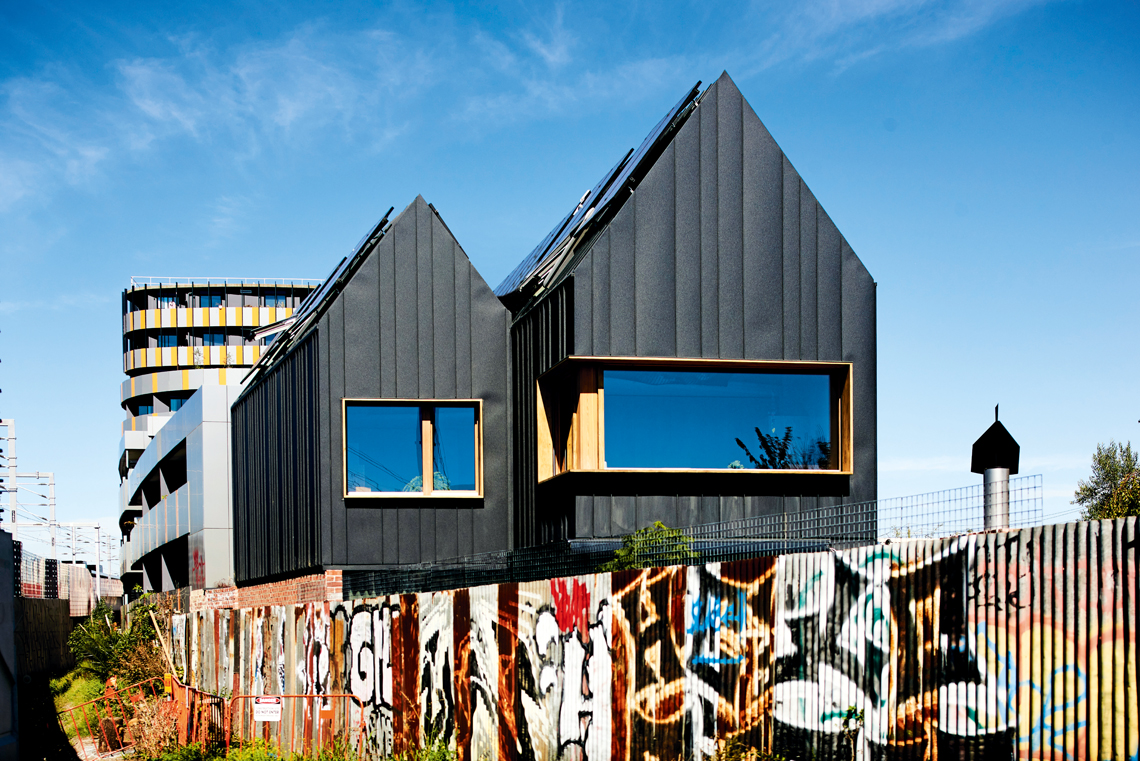The dream: to create a Passivhaus on a piece of forgotten land in the middle of Melbourne’s urban jungle in Coburg. However, if this wasn’t challenging enough, Felicity and Marc, both homeowners and architects, faced numerous obstacles along the way. First, they had to contend with devastating break-ins, which set them back significantly. Then, a global pandemic hit, further complicating their plans. To make matters worse, a shocking fire destroyed most of the nearly-finished home. Despite these setbacks, it was ultimately the unwavering support and love from friends, family, suppliers, and tradespeople that “brought this beauty back to life.”
Sustainability and Innovative Design
“The house of our dreams was meant to set a new benchmark in homes, contributing to a better world while achieving the highest living experience,” say homeowners Felicity and Marc. “A high-performance Passivhaus that doesn’t require heating or cooling. A contemporary living experience that combines playful adventure with luxury living and high levels of sustainability. A family home that is meant to be an inspiration.”

Coburg Passivhaus is a four-bedroom family home featuring two living spaces, three bathrooms, a roof garden, a garage, and a backyard complete with a fishpond, aquaponics, and a treehouse. This home beautifully blends functional playfulness with highly sustainable building techniques and materials. Moreover, these elements have been utilized in fun and innovative ways, making it both environmentally friendly and full of character. Built from recycled bricks that Felicity and Marc collected and cleaned themselves, along with playful elements like the Oxley hanging nets, a living green wall and cubby-holes between the kids’ rooms, every element of Coburg House aims to create a building that is “good for the planet but also good for the people living in it”.
The Passivhaus Standard and Construction Challenges
Passivhaus is a German certification that stands for “thermally super-efficient homes that can hold the internal temperature without heating and mostly without cooling”. Therefore, to achieve this, Coburg Passivhaus incorporates a range of advanced features, including triple-glazed windows, CLT structural panels, and 140mm wood-fibre insulation. In addition, the house is equipped with the highly efficient Zehnder HRV (heat recovery ventilation) unit, which further enhances its energy efficiency. As a result, Coburg House boasts a Near Net Zero Energy rating, making it a model of sustainability and efficiency. With the addition of Australian-made Tindo solar panels with Sonnen batteries, it will eventually be an energy-positive home. But creating this type of house is no simple feat; very specific and detailed planning and coordination were required by all involved.

Rebuilding After the Devastating Fire
When the Coburg Passivhaus was almost complete, a devastating fire, ignited by a heat gun, tore through the home. While Felicity and Marc watched their dream go up in flames, the crew watched all their hard work get destroyed too. However, this tight-knit team saw the fire as merely a setback, banding together to get this innovative home completed.
“While a standard Australian home is unsafe after minutes and will completely burn down in around one hour, our home withstood the flames for nearly 24 hours,” reveal Felicity and Marc. “While the house was heavily damaged by fire and water, the structure has been safe at all times as the wood-fibre insulation slowed down the burning process so much that the structure was only touched marginally in two very small areas. The fire has been very emotional for us and seeing the aftermath was extremely hard. But we are grateful that with the help of so many wonderful people, we could turn this dramatic event into a happy ending.”

Community Support and the Final Result
Supplier and friend Paarhammer Windows was one such business that stepped up to repair and remake windows and doors, which had previously taken months for the original international manufacturer to deliver. Additionally, Home by Hütt, Eckersley Garden Architecture, G-Lux, Viz Built, and Zinclad are other businesses that Felicity and Marc felt deserved special mention for their invaluable contributions to the Coburg Passivhaus project. The result is a Passivhaus that “cuts a wonderful balance between creating a nurturing and relaxing aura while offering a joyful, luxurious lifestyle at the highest level. It’s a combination of functional playfulness, healthy and environmental choices, lasting quality with luxurious lifestyle choices that create a new way of living.”














